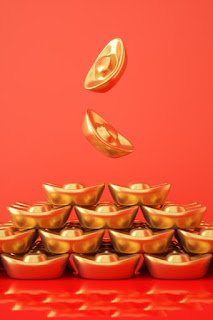Prosperity bowls, Wealth bowls, or Money Jars are basically containers that are filled with items or charms that are associated with attracting material abundance into one's life. Although this practice is commonly found in Buddhist households and establishments, it is not exclusive to only one Asian religion and culture; the practice of preparing wealth bowls is actually one tied to metaphysical principles (Feng Shui) and cultural superstitious beliefs on positive manifestations.
Estimated Reading time: 7-8 min
CONTENTS:
I. Common Forms of Wealth Bowl
1.1 Fruit Bowl
1.1.2 Unlucky numbers
1.2. Ingot Bowl
1.3. Classic Wealth Bowl
II. How to Prepare Your Own Bowl
2.1 Items to be put in the bowl
2.1.2 Additional items for customizing your bowl
2.2 Choosing and Preparing the bowl
III. Where to Place Your Wealth Bowls
IV. Blogger's take (Actual Example from Recycled Jar)
I. COMMON FORMS OF WEALTH BOWL
1.1 FRUIT BOWL:
Here's something that is considered a "wealth bowl" in a figurative sense, but is technically NOT one: The Celebratory Fruit Bowl table centerpiece. For many Asians who practice Feng Shui, preparing a fruit bowl isn't just about putting together your favorite fruits in the middle of the dining table as an edible and healthy centerpiece. It is also done to invite abundance into the home. Especially during special occasions-- New Year, birthdays, festivals, a certain number and type of fruits are put together in one bowl or basket to bring luck into the celebration, and hopefully, for the whole year, starting the day of the occasion. Round fruits are generally considered lucky. Thus, oranges are usually staples in the lucky fruit bowl.
The quantity for each type of fruit placed in one bowl are commonly 1,2,3,8, and 10. Some households who are not fixed on following traditional Feng Shui will overlook the numbers and fit in as many fruits as they can based on their preference, but the numbers 4 and 13 are still often avoided.
The Unlucky numbers:
- Four: 四 (four) and 死 (radical for "death") are both pronounced as "si" in Chinese and many Chinese-influenced languages, so the number is often avoided in establishments and households that are heavy on observing Chinese superstitions.
- Thirteen: Not all Asian cultures see 13 as an unlucky number. However, countries that are heavy on Western superstitions and religious influences tend to avoid it. This may be because of the biblical association with the "Last Supper"; "In the Bible, Judas Iscariot, the 13th guest to arrive at the Last Supper, is the person who betrays Jesus. Meanwhile ancient Norse lore holds that evil and turmoil were first introduced in the world by the appearance of the treacherous and mischievous god Loki at a dinner party in Valhalla. He was the 13th guest, upsetting the balance of the 12 gods already in attendance." (History.com, Maranzani, 2021)
As a child, I have heard the elderly avoid both 4 and 13. They never really explained to me why the two numbers were considered unlucky. And whenever I asked, they will just tell me that it's a superstitious belief passed down to them by their own elders. Many of them, regardless of religion, observed the practice of dreading and avoiding the numbers like a plague.
As I grew up, I have noticed both numbers be avoided in different building floors in both Asian and Western establishments. Elevator buttons would skip on either 4 or 13. I remember a hotel in HongKong avoiding both. Their building could have a total of 23 floors, but have 1-25 on the buttons with 4 and 13 being absent on the dial pad.
1.2. INGOT BOWL:
Have you seen those boat-looking gold pieces in Oriental-themed houses and Buddhist temples? These Chinese ingot called "yuan bao" (元宝) was once used as an actual currency until the Qing Dynasty in China. Over the years, the imagery of the boat-shaped Chinese nuggets remained, and was passed down for generations as a symbol of prosperity. The shape would be printed on stickers, carved out from crystals, manufactured from plastic, or cut out on colored papers for decoration during New Year celebrations to invite money to come in. It would also often be placed by an altar, a designated "wealth" corner, or by the cashier section in some business establishments.
1.3. Classic Prosperity Bowl:
A prosperity bowl can be made of wood, glass, clay, or porcelain. It often does not have lid, and is just any type of bowl that has coins and sometimes rice grains in it.
II. HOW TO PREPARE YOUR OWN WEALTH BOWL
- Rice Grains- Associated with bountiful harvest and being well-fed. A spoonful of rice grains is fine (UNCOOKED, okay? Don't go fermenting cooked rice in that bowl. This isn't a blog post on mold/bacteria-culturing or sake-making).
- Coins- It doesn't have to be old Chinese coins; you can use loose change or old coins of whatever currency is available to you.
- Crystals/Gemstones- I recommend putting in once that are associated with abundance and business, such as jade, pyrite, garnet, tiger's eye, aventurine, and/or citrine.
- Charms associated with Prosperity and Abundance- this can be those little charms in the shape of coins, currency symbols, or even little, loose pieces of beads (such as pearls or random crystals you no longer use) from your trinket stash which you associate with looking and feeling more "luxurious".
- Image or little icon of deity or guardian associated with wealth- You can include a small picture or carved amulet piece of any deity, guardian, or saint which your religion or craft associates with wealth.
- A wealth mantra- you can write a mantra inviting abundance into your life on a piece of paper and fold it.
- You can use a bowl/jar made of plastic, porcelain, brass, or whatever material you have in mind. But remember that the more durable and weather-proof it is, the better. The container symbolizes what holds and will catch your wealth. It has to be able to withstand different environmental conditions.
- You can buy or use any available bowl or jar to your liking. If you have the time and money to spare, you can even find traditional wealth bowls with zodiac animal prints or mantra carvings on them. If you're feeling crafty, you can get a jar or a bowl and redecorate it as you see fit.
- Make sure the bowl or jar is completely empty and clean. If you decide to recycle old product containers, remove any sticker labels. You can also repaint it with your favorite color or any lucky color associated with money and riches (gold, silver, or green).
- Use a container with a lid. Closing the bowl/jar secures its contents from spilling or being grabbed by someone else-- both in a literal and figurative sense.
- Smudge or smoke-cleanse your jar before filling it.
- Place in a well-lit area
- Avoid placing in spots next to doors or windows; you don't want your wealth "escaping" or getting sucked out by these big holes.
- Make sure there's a wall or a fence protecting one side of the bowl if you can't avoid placing it in open spaces next to large windows.
- Keep the are clutter-free at all times; treat it like a sacred space for gathering "Wealth energy"
- Simple placement: You may place your wealth bowl in the "Wealth Corner"; find the farthest left corner of the room across where the entrance door is located-- that's the simplified way of locating it.
- Specific placement: For a more specific directional guidance, you may try referring to "Bagua maps" online (I'm in no way associated with this website, but I do find this guide very simple and helpful).













